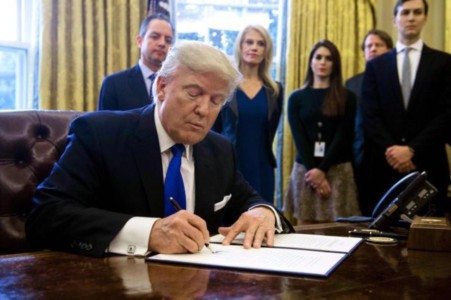
President Trump on Wednesday signed two executive orders on immigration, including one that directs federal agencies to begin construction of a wall on the border with Mexico, his signature campaign promise.
Trump signed the actions during a visit to the Department of Homeland Security (DHS) as his aides met in the White House with two top Mexican cabinet officials.
“A nation without borders is not a nation,” Trump said during a speech at DHS headquarters. “Beginning today, the United States of America gets back control of its borders.”
The president said his directive “will save thousands of lives, millions of jobs, and billions and billions of dollars.”
One of the orders signed by Trump calls for the construction of “a large physical barrier on the southern border,” according to White House press secretary Sean Spicer.
The other order deals with immigration enforcement and ends the “catch and release” policy that quickly returned border crossers back to Mexico instead of arresting and processing them for deportation. The policy was a fixture of the Bush administration and was later reinstated on an informal basis by former President Barack Obama.
“Federal agents are going to unapologetically enforce the law, no ifs, ands or buts,” Spicer said.
The immigration actions also seek to withhold visas from countries to make sure they take back people in the U.S. illegally who are found to have broken U.S. laws. It would also strip federal grants from “sanctuary” cities and states that do not enforce federal immigration laws.
“We’re going to strip federal grant money from the sanctuary states and cities that harbor illegal immigrants,” Spicer said.
The president pledged during the 2016 campaign he would make Mexico pay for the border wall, which is meant to cut off the flow of drugs and illegal immigration, but now says the federal government will be “reimbursed at a later date.”
“I’m just telling you there will be a payment. It will be in a form, perhaps a complicated form. What I’m doing is good for the United States. It’s also going to be good for Mexico. We want to have a very stable, very solid Mexico,” Trump said Wednesday in an interview with ABC.
At a press conference earlier this month, Trump said he didn’t want to wait “a year-and-a-half until I make my deal with Mexico” for work on the wall to begin.
Trump added in the ABC interview that work on the project could begin within months.
“As soon as we can, as soon as we can physically do it,” he said. “I would say in months, yea. I would say in months — certainly planning is starting immediately.”
The construction of the wall is expected to be controversial, and is already drawing criticism for its potential human consequences and cost.
Marielena Hincapie, executive director of the National Immigration Law Center, called Trump’s executive actions on immigration “incoherent and a monumental waste of taxpayer money.”
Paying for the wall is likely to be a top issue as Trump seeks to renegotiate the North American Free Trade Agreement (NAFTA) with Mexico and Canada.
Mexico’s secretary of the economy, Ildefonso Guajardo, one of the attendants at Wednesday’s White House meeting, warned Tuesday that a demand to pay for the wall would cause Mexico to withdraw from renegotiation talks on NAFTA.
Estimates for the cost of the wall range from $8 billion to $25 billion dollars. While existing legislation authorizes the construction of border fencing, Trump will likely need to ask Congress for money this year.
On the campaign trail, Trump initially suggested paying for the wall by taxing or impounding remittances — the money immigrants send to their families abroad. Some experts panned the idea, saying it would be legally impossible to single out Mexican remittances from those going to other countries.
The construction of the wall is expected to face major challenges, given the terrain it would have to cover and the areas it would have to pass through.
The U.S.-Mexico border goes through large metropolitan areas, such as El Paso-Ciudad Juarez and San Diego-Tijuana, which are largely walled off already; rural areas, including farms that in some cases straddle both sides of the border; and inhospitable wilderness, including national parks.
Of the almost-2000 miles of border, 653 miles are already covered by a hodge-podge of fences mostly built since the late 1990s. Most of the fencing — 444 miles — was ordered built by the 2006 Secure Fence Act signed by President George W. Bush.
Wednesday’s executive order mandates new construction under the same Secure Fence Act.
The Rio Grande forms a natural barrier along most of the eastern border region, leaving only the most remote and rugged areas exposed.
While the number of border crossings has leveled off at around 400,000 a year since 2010 (hitting a low comparable to crossings in the 1970s) the number of Mexican nationals attempting to cross has continued to decrease.
In fiscal 2014 and 2016, Mexican nationals accounted for less than half of all illicit border crossings.
This story was updated at 3:05 p.m. Jordan Fabian contributed.
Source: The Hill
